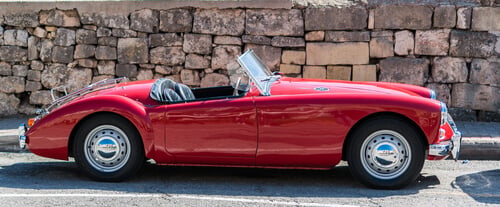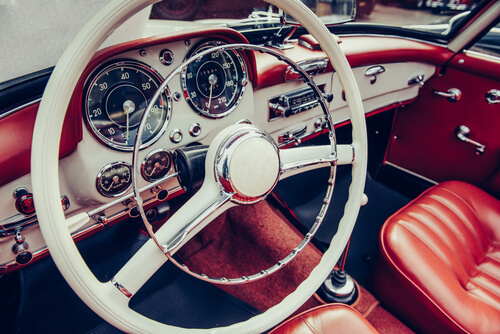
Reading Time: 6 minutes
So, how do you go about storing a classic car properly?
Your classic car is more than just a thrill on wheels; it’s a precious investment. Knowing how to store it right this year, is crucial for keeping its charm and value intact.
Think of ‘classic’ as a symbol of top-notch quality, much like the ’64 Pontiac that steals the show in your driveway. The real deal is figuring out the best ways to store these beauties.

We’re here to give you handy tips on classic car storage. We’ll make sure when it’s time to hit the road or the show, your prized ride is looking and running at its best. Plus, we’ve got your back for safe, scratch-free shipping.
In this post Nationwide Auto Transportation shares a few classic car storage hints and tips, so when it’s showtime and your baby is looking her best, we will ship her safely and scratch free for everyone to see.
Your To-do List for Storing a Classic Car
Classic cars are an investment that deserves protection, as any car collector would agree. The classic car is often a long-term investment, whether it is purchased or restored, so it only makes sense to keep it in the best condition possible. It makes sense to protect your classic car from damage by storing her under proper conditions when you will not be driving her for an extended period.
Your next question will most likely be, “How do you store a classic car?”, and I will answer with, “not by driving it into your garage or a storage unit and locking it!” Long-term storage of your car without the proper preparation could be harmful to your engine and car, so when this need arises to put your investment to bed for a couple of months, follow these tips to prevent damage and maintain the quality and performance that you expect from your investment.

Storing a Classic in the Right Environment
When you have spent a considerable percentage of your income on something, it is natural to want to take care of your purchase, and if it is a vintage, classic, or sports car, the stakes are raised by a few thousand dollars, give or take.
A climate-controlled indoor drive-up storage unit is one of the best ways to store your classic car. You can keep your car protected from the elements and prevent the sun’s rays from fading your paint. Moreover, the climate control system will protect the paint, upholstery, tires, and engine from deterioration. Adding a plastic sheet to the flooring can serve as a vapor barrier that prevents moisture from entering under the car. Don’t forget to choose a storage unit that is the right size—common sense states that if you squeeze your vehicle into a tight space, you risk dings or scratches.

Detail and Clean Your Car
It is time to start thinking about storing your classic car after a wonderful summer of driving, and yes, storage is an important part of maintaining your car. Any damage could affect how it looks and performs, and also impact its value.
It is important to make sure that the space you plan to store your car is clean, dry, and damp-free before parking it, as any moisture or dampness could lead to corrosion or mould growth.
- Wash, wax, and polish your classic thoroughly – As a classic car owner you have probably washed, waxed and polished your baby more times than Americans said “wtf?” during the Trump administration. Suffice to say, your car needs to be free of dirt, salt, and moisture if you want it to be protected from corrosion. It requires a thorough cleaning and waxing to protect the paintwork. Want to know more? Read Ceramic Car Coating: Why Should You Get Ceramic Coating for Your Vehicle?

Don’t forget to make sure that any rubber parts, hinges and other moving parts are coated with lubricants. This is to prevent rust, jamming and rubber that may perish.
Looking to keep your classic car in pristine condition? Proper storage is key! Check out Hagerty’s classic car insurance for expert tips. 🚗🔧 #ClassicCarCare
Service Before Storing an Antique
You may think it sounds strange to perform maintenance on your vehicle when it is just going to be standing there? Believe me when I say you will not regret it.
- Change the oil – oil contains harmful contaminants that damages your engine when left standing. Make sure that the engine runs long enough for the new oil to coat all the parts of the engine.
- Fill your tank with fresh fuel before putting your classic to bed. Add fuel stabilizer and anti-freeze during winter, make sure your coolant levels are at their peak.
- Plug your exhaust with steel wool to keep the critters from crawling up your pipes and destroying your wiring. Remember to remove it before starting your car or else you may be in for a butt of a jump!
How do you store your classic? | Have a CHECKLIST
- Take out the battery and make sure you charge it before storing it properly. You can give it a bi-weekly boost to make sure it stays fresh. This will help to maintain the life of your car battery. It also prevents corrosion and damage caused by leaking battery acid.
- Put your car on wheel blocks, or use jack stands to elevate the tires from the floor. You reduce the risk of having to buy new tires after a long stand. Gravity ensures that tires get flat at the bottom, causing them to ellipse and have an oval shape. This is not safe for driving.
- Storing a classic car means covering it – literally. You should invest in a quality car cover even if your car is in covered storage. It will simply add another layer of protection against dirt, insects, and dust. Select a cover with a soft interior so the paint won’t be scratched. Use a breathable material so moisture won’t collect.
How to Maintain
Your work isn’t finished just because your car is parked for winter. To keep your vehicle in good condition, it must be maintained regularly. This will keep it ready for those dry winter days when you may just decide to rev it up a bit, or just take it for a drive.
Maintain your car through the winter
- Make sure you regularly check the fluid levels of your classic car. If the oil, coolant, brake fluid, and transmission fluid are low, you could cause catastrophic engine damage. As mentioned above, ensure the coolant/antifreeze in the system is winter-ready, so that it won’t freeze when the car is parked for a long time.
- A lot of classic cars have minor rust spots, but they can easily worsen if not treated. You should apply lubricant regularly to your car while it is stored for the winter to slow down the spread of rust and prevent further corrosion.
- Starting the engine every few weeks is a good idea, as it will recharge the battery and allow fluids to circulate throughout the engine. Having your vehicle ready gives you peace of mind when you want to drive it.
- When you go out for a drive, be sure to clean your car afterward. Salt from roads can get into your car’s undercarriage on dry days, and this can lead to all kinds of problems if not addressed. Rinse the sills and undercarriage with a hose, then dry them off before putting the car back in the garage.

After Storing a Classic Car | It’s Shipping Time
For any classic car owner or enthusiast, owning your dream car could mean buying it online or at an auction out of state. However, at some stage you will almost certainly need professional auto transport for classic cars.
An older car doesn’t need to rack up more unnecessary miles. That is why experienced exotic car owners put their trust in reliable classic car transportation services like Nationwide Auto Transportation – because we take their precious ladies home safely and scratch-free, every time.

Give us a call or contact us today to book your classic car shipping.



